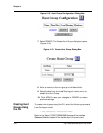
4-24
Chapter 4
Cajun P550/P880/P882 Switch User Guide
There are six Non-Member PLEs (the 12 port is associated with a
single fabric port but has two PLEs – one in the routing path and one
before the routing path, and the 4 port has a PLE per port). Load
sharing is now accomplished by Destination MAC Address and
Source PLE. When Mac Address 1 is learned, it is assigned to the first
Hunt Group link for PLE#1, the second for PLE#2, the first for
PLE#3, the second for PLE#4, the first for PLE#5 and the second for
PLE#6. The second MAC Address is round-robin assigned in the
same fashion and so on. Since the number non-member PLEs is
divisible by the number of ports in the hunt group – load sharing
does not occur when ALL traffic is sourced from the same PLE (e.g.
all PLE#1 unicast packets traverse the same link).
Figure4-15 shows a second load-sharing example.
Figure 4-15. Load-Sharing Example 2
In Figure4-15, the first MAC Address is assigned to the first port in
the Hunt Group for PLE #1, the second port in the Hunt Group for
PLE#2, the third port in the Hunt Group for PLE#3, the first port in
the hunt group for PLE#4, the second port in the Hunt Group for
PLE#5, the third port in the Hunt Group for PLE#6, and the first port
in the Hunt Group for PLE#7.
The second MAC Address is then learned on the second port in the
hunt group for PLE#1, the third port in the Hunt Group for PLE#2,
the third port in the Hunt Group for PLE#3, the fourth port in the
hunt group for PLE#4, and so on. The load sharing problem is
alleviated even though all traffic is the sourced from the same PLE
(data from PLE#1 is split between the three links). Since the case in
Figure 4-5 is not expected in live networks, it is not viewed as a
serious issue with the P550 hunt group implementation.
L3 CPU L3 CPU
12 port 10/100
empty
4 Port Gig empty
empty
A B C D 1 2 3 4
Hunt Group
PLE#5, PLE#6
PLE#7
PLE#1, PLE#2
PLE#3, PLE#4
empty
empty
4 Port Gig
12 port 10/100
empty
PLE#1:1,PLE#4:1, PLE#7:1, PLE#3, 2,
PLE#6,2, PLE#3,2
PLE#2:1, PLE#5:1, PLE#1:2,
PLE#4: 2, PLE#7,2
12 port 10/100 12 port 10/100
PLE#3:1, PLE#6:1, PLE#1:3,
PLE#2, 2, PLE#3,1


















